Digital Poster Session
MR Safety: Interventional MR and Safety Issues
MR Safety
4171 -4186 Interventional MR and Safety Issues - Implant Safety
4187 -4202 Interventional MR and Safety Issues - RF Safety
4203 -4218 Interventional MR and Safety Issues - Gradient & B0 Safety
4171.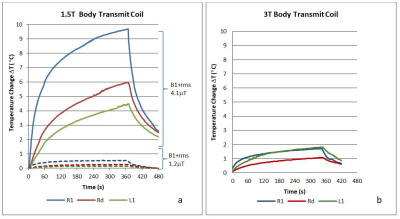 |
1.5T and 3T MRI safety of a deep brain stimulation system: in vitro temperature measurements
Annie Papadaki1,2, Hassan B Hawsawi3,4, Ali Rajabian@nhs.net5, Louis Lemieux3, Ludvic Zrinzo5, and John S Thornton1,2
1Lysholm Department of Neuroradiology, UCLH, London, United Kingdom, 2UCL Institute of Neurology, :ondon, United Kingdom, 3Department of Clinical and Experimental Epilepsy, UCL Institute of Neurology, :ondon, United Kingdom, 4Administration of Medical Physics, King Abdullah Medical City (KAMC), Makkah, Saudi Arabia, 5Unit of Functional Neurosurgery, Sobell Department of Motor Neuroscience and Movement Disorders, UCL Institute of Neurology, London, United Kingdom
The aim of this study was to compare RF-induced heating in an in vitro model of an implanted Boston Scientific Gevia DBS device between 1.5T and 3T MRI. We assessed temperature changes in a phantom simulating a patient with a bilateral DBS neuromodulation device in different transmit coils, lead configurations and 3T B1 shimming options. Highest temperature increase was recorded at the distal electrode contact during 1.5T MRI in the body transmit coil. Phantom tests showed that lead arrangement, B1 shimming and DBS system configuration can have significant effect on temperature recorded near the contacts.
|
|
4172.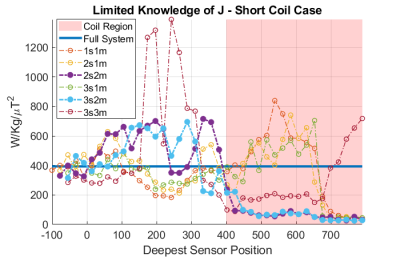 |
A Framework for Worst-Case SAR Reduction when Controlling Induced Currents on Elongated Conductors using Parallel Transmit
J. Nuno Teixeira1, Felipe Godinez1, Shaihan Malik1,2, and Joseph V Hajnal1,2
1Biomedical Engineering Department, School of Biomedical Engineering & Imaging Sciences, King's College London, London, United Kingdom, 2Centre for the Developing Brain, School of Biomedical Engineering & Imaging Sciences, King's College London, London, United Kingdom
MRI with elongated conductors (“wires”), risks tissue heating and reduced image quality. Parallel Transmit (pTx) systems can be configured to generate useful magnetic fields while reducing currents on wires, provided suitable current sensing is achieved. We propose a framework based on a current mode analysis for determining worst case SAR (wcSAR) when driving a pTx array so as to remove high current modes. This approach is demonstrated using FDTD simulations of two 8 channel pTx coils allowing comparison of full knowledge of currents with restricted point measurement, systematically determining the impact of current sensor number and location on wcSAR control.
|
|
4173.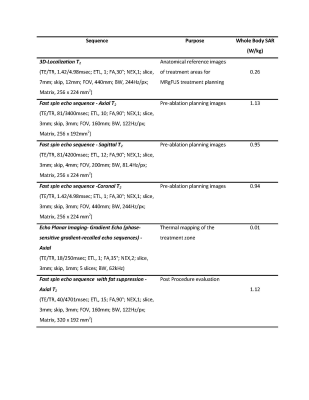 |
Magnetic Resonance Imaging-guided Focused Ultrasound ablation of lumbar facet joints of a patient with a MRI non-conditional pacemaker at 1.5T
Jacinta Browne1, Christin A Tiegs-Heiden1, Vance T Lehman1, Zaiyang Long1, Robert E Watson1, Gina K Hesley1, and Krzysztof R Gorny1
1Radiology, Mayo Clinic, Rochester, MN, United States
An MRgFUS ablation treatment of lumbar facet joints in a patient with a traditional MRI non-conditional pacemaker was completed. A risk-benefit analysis by a coordinated multi-disciplinary team prior to this treatment was performed to account for the risks associated with traditional MRI non-conditional pacemaker. The treatment was successfully performed as per our institution established cardiac implanted electronic device (CIED) MRI practice and the patient had no adverse cardiac event during or following this procedure. By careful use of our institutional CIED MR-practice guidelines, we demonstrated that such treatments can be safely achieved for patients with CIEDs on a case-by-case basis.
|
|
4174.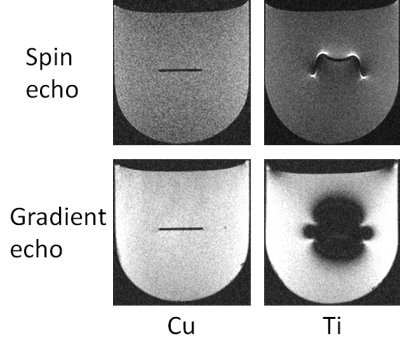 |
Analysis of changes in magnetic susceptibility artifacts due to static magnetic field strength, imaging sequence and chemical composition
Ryusuke Nakai1, Seiji Yamaguchi2, Mitsuaki Toda3, Takashi Azuma4, and Hiroo Iwata4
Video Permission Withheld
1Kokoro Research Center, Kyoto University, Kyoto, Japan, 2College of Life and Health Sciences, Chubu University, Aichi, Japan, 3Graduate School of Health Care Sciences, Jikei Institute, Osaka, Japan, 4Graduate School of Medicine, Kyoto University, Kyoto, Japan
Reducing or resolving susceptibility artifacts is important for development of materials for medical implants. In this study, we measured and evaluated magnetic susceptibility artifacts for various metals and ceramics using two MRI systems with different static magnetic field strengths and multiple imaging sequences. MR images were acquired following the criteria of the spin echo sequence and gradient echo sequence required in the US FDA standard artifact evaluation test. The results were used to clarify the relationships among artifact size in MR images, volume magnetic susceptibility of samples, and static magnetic field strength of the MRI system.
|
|
4175.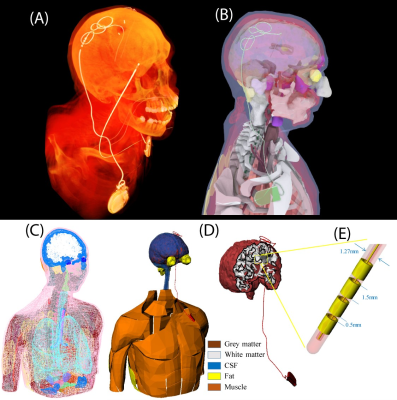 |
Simulation strategies to assess RF heating of implants: Do we need a paradigm shift?
Bach Thanh Nguyen1, Julie Pilitsis2, and Laleh Golestanirad1
1Department of Radiology, Northwestern University, Chicago, IL, United States, 2Department of Neurosurgery, Albany Medical Center, Albany, NY, United States
Numerical computation of radio-frequency (RF) fields in human body with implants is currently the only practical approach to obtain reliable estimation of the specific absorption rate (SAR) for safety assessment. Here we examine how detailed the model of a human body with a deep brain stimulation (DBS) implant needs to be to provide predictions of worst-case SAR scenarios for safety assessments.
|
|
4176.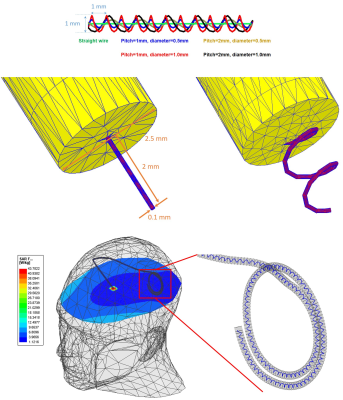 |
Interdependency of SAR amplification on external trajectory and internal geometry of implanted leads during MRI at 3T
Bach Thanh Nguyen1, Bhumi Bhusal1, and Laleh Golestanirad1
1Department of Radiology, Northwestern University, Chicago, IL, United States
One of the most crucial MRI safety concerns for patients with implanted leads, such as deep brain stimulation or spinal cord simulation implants, is to predict the worst-case RF heating. Simulations are increasingly used to search for lead trajectories that generate maximum SAR amplification in the tissue, however, due to limited computing resources such models dramatically simplify internal structure of the leads. Here we show that both the internal geometry and trajectory of implanted leads need to be accounted for reliable SAR prediction. Contrary to the general belief, leads with tightly-coiled internal wires do not always generate less RF heating.
|
|
4177.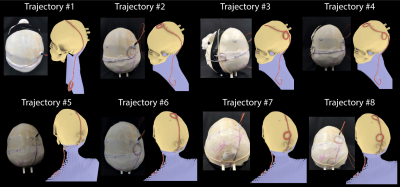 |
Effect of device configuration and patient’s body composition on RF heating of deep brain stimulation (DBS) implants during MRI
Bhumi Bhusal1, Joshua Rosenow2, Bach Nguyen1, Jasmine Vu1, Noah Pasquinelli1, and Laleh Golestanirad1
1Northwestern University, Chicago, IL, United States, 2Northwestern Medicine, Chicago, IL, United States
Off-label use of MRI in patients with DBS implants has been reported at 3T, relying only on safety tests in ASTM phantoms and with limited configurations. We constructed a multi-compartment anthropomorphic phantom consisting of brain, skull and body tissue, and measured RF heating of a fully implanted DBS system with various configurations during MRI at 1.5T. We found an 89-fold variation in RF heating depending on DBS device configuration. Simulating subcutaneous fat (as happens in obese patients) by adding a thin layer of oil to cover the upper face of the IPG increased RF heating by 3-fold in some configurations.
|
|
4178.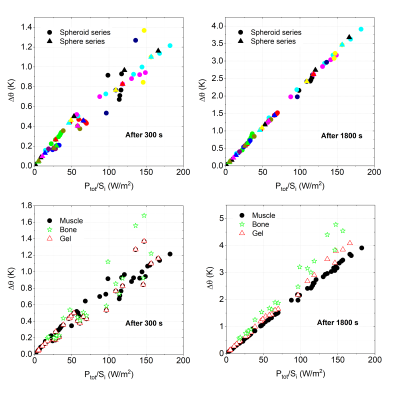 |
Parametric analysis of gradient-induced heating in simplified models of metallic implants
Alessandro Arduino1, Umberto Zanovello1, Luca Zilberti1, Mario Chiampi1, and Oriano Bottauscio1
1INRiM, Torino, Italy
MRI safety for patients carrying metallic implants, whose prevalence grows continuously, has become a matter of concern, so that risk assessment for passive implanted medical devices is important for both radiologists and implant manufacturers. A wide analysis of parameters influencing the thermal effects of Gradient Coil fields is here performed. Results show that it seems possible to identify some general rules related to this cause of heating, also in view of future standardized approaches.
|
|
4179.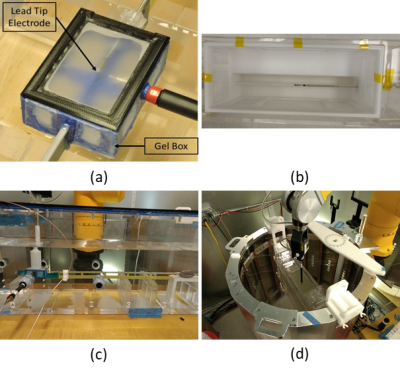 |
MRI RF Safety of Active Implantable Medical Devices (AIMDs): Tissue Simulating Medium properties for accurate modeling of MRI-conditional AIMDs
Harish Kamineni1, Paul J Stadnik2, Jeffrey A VonArx2, Larry Stotts2, Ji Chen3, and Krishna KN Kurpad2
1Electrical & Computer Engineering, Texas A&M University, College Station, TX, United States, 2Micro Systems Engineering Inc., Lake Oswego, OR, United States, 3Electrical & Computer Engineering, University of Houston, Houston, TX, United States
The Tier 3 procedure for testing electrically long active implantable medical devices (AIMDs) for MRI RF safety involves the development of transfer function models (TFMs) of the AIMDs. Accuracy of the TFM depends on how closely the TSM mimics the tissues in which the AIMD is implanted. We find that the conductivity of the medium surrounding the lead electrode has a strong influence on the transfer function magnitude of the DUT. Therefore, TFMs of the DUT developed in a TSM whose conductivity mimics that of the in-vivo tissue that surrounds the electrode under test results in the most accurate TFM.
|
|
4180.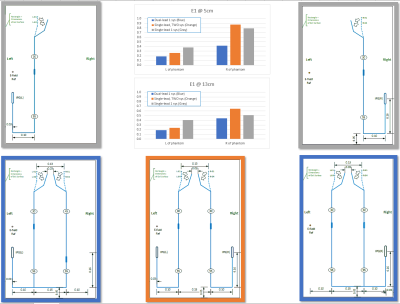 |
Impact of a neighboring device on in vitro lead heating measurements
Louai Aldayeh1, Mizan Rahman1, and Ross Venook1
1Boston Scientific, Valencia, CA, United States
For patients with more than one MR Conditional implant, it is unclear how to choose appropriate scanning conditions, as interactions between neighboring devices are generally not well characterized. This work assesses how lead electrode heating of an IPG/lead based system can be impacted by the presence of a neighboring IPG/lead based system at moderate distances (~15cm). The results demonstrate that lead electrode heating can either decrease or increase, depending on the relative location of the neighboring device. The potential implication is that established conditions for MR safety of one implant may not be appropriate in the presence of neighboring implant.
|
|
4181.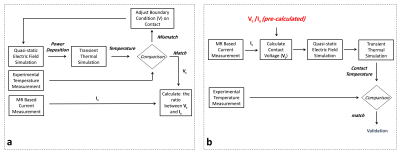 |
A Temperature Prediction Workflow for DBS Electrodes Undergoing MRI
Alireza Sadeghi-Tarakameh1,2,3, Noam Harel3, Ergin Atalar1,2, and Yigitcan Eryaman3
1Department of Electrical and Electronics Engineering, Bilkent University, Ankara, Turkey, 2National Magnetic Resonance Research Center (UMRAM), Bilkent University, Ankara, Turkey, 3Center for Magnetic Resonance Research (CMRR), University of Minnesota, Minneapolis, MN, United States
We present a workflow consisting of a simple quasi-static EM model and a thermal transient simulation model for predicting temperature around commercial DBS electrodes. The model was able to predict the heating at a single contact accurately for different trajectories.
|
|
4182.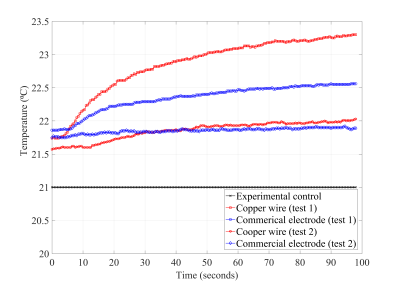 |
MRI safety of deep brain stimulation devices: Radiofrequency heating of a commercial lead and an insulated copper wire
Benson Yang1,2, Fred Tam1, Benjamin Davidson3, Clement Hamani3,4, Nir Lipsman1,3,4, Chih-hung Chen2, and Simon J Graham1,5
1Physical Sciences, Sunnybrook Research Institute, Toronto, ON, Canada, 2Electrical and Computer Engineering, McMaster University, Hamilton, ON, Canada, 3Division of Neurosurgery, Sunnybrook Health Sciences Centre, Toronto, ON, Canada, 4Harquail Centre for Neuromodulation, Sunnybrook Research Institute, Toronto, ON, Canada, 5Medical Biophysics, University of Toronto, Toronto, ON, Canada
Magnetic resonance imaging (MRI) safety of deep brain stimulation (DBS) patients remains a concern. Because of this, researchers have relied on phantoms to mimic electromagnetic behavior. DBS devices are costly and as a result, copper wire is often used as a substitute to DBS leads. This work examines the suitability of using copper wire to emulate MRI-DBS interactions with results showing over 50 % reduction in temperature elevations when using a DBS lead.
|
|
4183.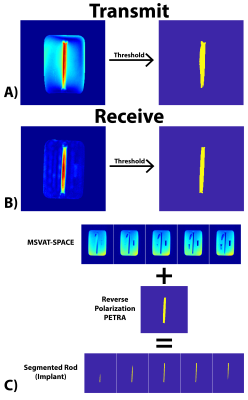 |
Patient-specific Implant Safety Assessment using Low-SAR Reverse Polarization Imaging and a Fast Electromagnetic Solver
Eugene Milshteyn1,2, Georgy D. Guryev3, Elfar Adalsteinsson3,4,5, Jacob K. White3, Lawrence L. Wald1,2,5, and Bastien Guerin1,2
1Athinoula A. Martinos Center for Biomedical Imaging, Charlestown, MA, United States, 2Harvard Medical School, Boston, MA, United States, 3Dept of Electrical Engineering and Computer Science, Massachusetts Institute of Technology, Cambridge, MA, United States, 4Institute for Medical Engineering and Science, Massachusetts Institute of Technology, Cambridge, MA, United States, 5Harvard-MIT Division of Health Sciences and Technology, Cambridge, MA, United States
Current characterization of RF-heating in orthopedic implants is based on electromagnetic simulations models and phantom experiments. However, these approaches may not accurately characterize the implant heating within a specific patient’s anatomy. A personalized medicine approach, whereby the patient-specific implant/body model is generated as the patient is in the scanner, may provide more accurate safety limits. In this study, we developed a low-SAR, fast methodology to scan and segment the implant and surrounding tissue, and calculate the 1g local SAR. Our combination of MSVAT-SPACE, reverse polarization PETRA, and a fast electromagnetic solver yields local SAR estimates in under 6 minutes.
|
|
| 4184. | Safety of active implantable hearing systems in MRI: an overview of the most common adverse events
Guy Fierens1,2,3, Nina Standaert4, Ronald Peeters5, Christ Glorieux1, and Nicolas Verhaert3,4
1Physics and Astronomy, KU Leuven, Leuven, Belgium, 2Cochlear Technology Centre Belgium, Mechelen, Belgium, 3Neurosciences, KU Leuven, Leuven, Belgium, 4Otorhinolaryngology, KU Leuven, Leuven, Belgium, 5Radiology, UZ Leuven, Leuven, Belgium
Patients suffering from disabling hearing loss are often treated via the implantation of an active auditory implant. Even though the use of MRI is often needed in a post-operative follow-up or for the diagnosis of other pathologies. Using MRI in this patient group however raises some concern due to several possible patient risks. The presented work provides an overview of the most commonly occurring adverse events by analyzing data reported to the Food and Drug Administration and the MEDLINE and EMBASE literature databases.
|
|
4185.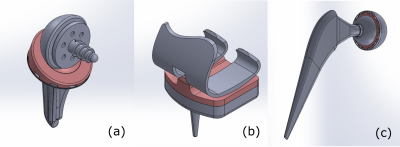 |
Heating risk by radiofrequency and switching gradient fields in the presence of metallic implants
Valeria Clementi1, Umberto Zanovello2, Alessandro Arduino2, Cristina Ancarani1, Barbara Bordini1, Oriano Bottauscio2, Mario Chiampi2, Luca Zilberti2, and Fabio Baruffaldi1
1Medical Technology Laboratory, IRCCS Istituto Ortopedico Rizzoli, Bologna, Italy, 2Istituto Nazionale di Ricerca Metrologica (INRIM), Torino, Italy
A growing number of patients with metallic implants are subjected to MRI exams, but a patient-specific heating risk assessment is not easily available. After a frequency analysis of databases collecting prosthetic patients data, a heating risk assessment, based on existing standards for RF fields and recent scientific studies for switching gradient coil fields, is performed. Results show that the whole body SAR estimation provided by the MRI scanner is not a self-reliant safety index for patients with metallic implants and suggest the need for a general procedure involving both RF and gradient coil fields induced heating.
|
|
4186.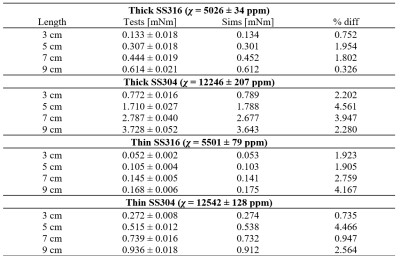 |
Modelling Static Field Induced Torque on Simplified Medical Devices
Xiao Fan Ding1, William B. Handler1, and Blaine A. Chronik1
1The xMR Labs, Department Physics and Astronomy, Western University, London, ON, Canada
The most recent published standard of static field induced torque on medical implants relies on solely experimental measurements. This study looks into the development of a computational method relying on the finite element method. It was found that for stainless steel rods, the percent difference between the numerical and measured torque values was less than 5%.
|
4187.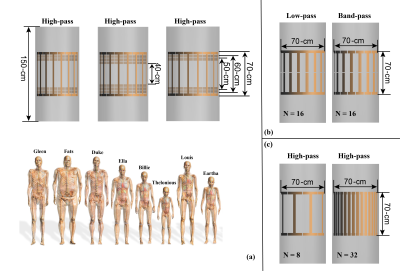 |
Radiofrequency-Induced Risks during Magnetic Resonance Imaging: Dependence upon Birdcage Design
Aiping Yao1, Manuel Murbach2, Tolga Goren1, and Niels Kuster1,3
1IT'IS Foundation, Zurich, Switzerland, 2UPV, Valencia, Spain, 3ETH Zurich, Zurich, Switzerland
The induced radiofrequency (RF) electrical field resulting in unwanted heating in patients with and without implants during magnetic resonance imaging (MRI) is a complex function of multiple factors which must be considered in patient risk assessment, including patient anatomy, imaging positions, RF characteristics of the implant, implant location, and MRI scanner design and scan configuration. In this paper, the dependence of the induced fields upon the birdcage design is investigated to determine the minimal range of RF body coils necessary to guarantee a comprehensive risk evaluation regarding heating and electromagnetic compatibility for any clinical MRI scanner.
|
|
4188.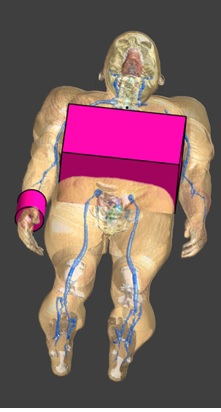 |
Simultaneous RF induced heating of the human body and RF coils: Implications for tissue temperature
Xin Chen1 and Michael Steckner1
1Canon Medical Research USA, Inc., Mayfield Village, OH, United States
It is widely understood that the B1 field used in MRI can cause significant tissue heating by inducing eddy currents. Additionally, the B1 field simultaneously induces heating in all RF coils. Patient heating is indirectly constrained by SAR limits, as defined in IEC 60601-2-33, and the surface contact coil temperature limit (41°C) is defined by IEC 60601-1. An examination of the simultaneous application of both heating sources is investigated by electromagnetic and thermal modeling. Initial results suggest that while the presence of a “hot” coil elevates tissue temperatures, the two simultaneous sources of heating don’t pose a patient safety risk.
|
|
4189.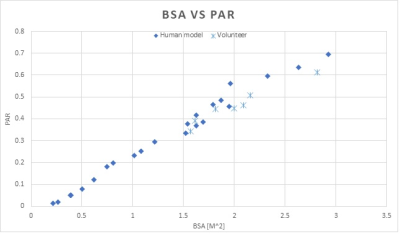 |
A method for MR system SAR control
Xin Chen1, Sadanori Tomiha2, Shinji Mitsui2, Yoshinori Hamamura1, and Michael Steckner1
1Canon Medical Research USA, Inc., Mayfield Village, OH, United States, 2Canon Medical Systems Corporation, Otawara-shi, Japan
This work demonstrates a SAR calculation method that manages the relationship between power deposition and patient body habitus.
|
|
4190.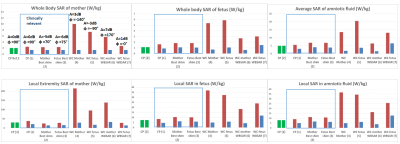 |
3T RF Simulations of Pregnant Women and MR System Behaviour
Cecilia Possanzini1, Zhiyong Zhai2, and Paul Royston Harvey1
1MR R&D, Philips Healthcare, Best, Netherlands, 2Philips Healthcare, Gainesville, FL, United States
Scanning pregnant women in MRI systems operating at 3T has been a controversial issue with respect to RF exposure and RF field uniformity. The latter issue is solved by 3T parallel transmit systems. In this work, we demonstrate that, when scanning in normal operating mode, the simulated RF exposure increase is limited to an acceptable level when the real behaviour/constraints of the system are taken into account.
|
|
4191.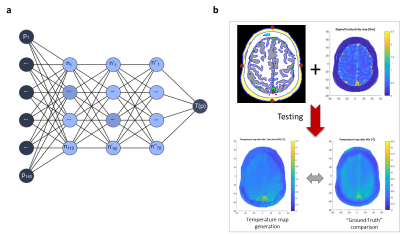 |
Intra- and inter- brain RF heating prediction with the Non-Invasive Temperature Estimation (NITE) method
Julie M. Kabil1, Sairam Geethanath1, and J. Thomas Vaughan1
1Columbia Magnetic Resonance Research Center, Columbia University, New York, NY, United States
Radiofrequency-induced heating is a major concern in MRI and these risks widely vary between patients. Therefore, we propose a personalized, deep learning temperature estimation method. After electromagnetic and thermal simulation on two human models in a radiofrequency coil, we trained a neural network on one brain slice to predict internal brain temperatures, using the following features: tissue properties, distance to four surface sensors and the corresponding four surface temperatures. Fast testing performed on both intra- and inter- brain slices revealed similar thermal maps compared to simulated maps. Ongoing work targets a better generalization to different anatomies and in vivo experiments.
|
|
4192.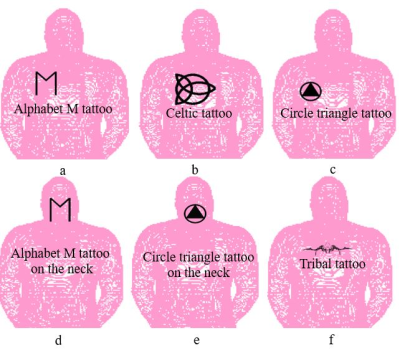 |
Computational Study of RF Induced Heating and Safety for Tattoo Patients under MRI
Shahzeb Hayat1, Youngdae Cho1, Sukhoon Oh2, and Hyoungsuk Yoo1
1Biomedical Engineering, Hanyang University, Seoul, Republic of Korea, 2Center for Research Equipment, Korea Basic Science Institute, Daejeon, Republic of Korea
Patients with permanent cosmetics and tattoos have potential risk of heating effects during MRI examination. Most of the cutaneous reaction and injury occurred around the tattoos due to the metallic pigments found in the tattoo inks. Previous reports and studies presented that mild edema and redness of the tattoo comprehended as cutaneous burn due to the shape of the tattoo. This study numerically analyzed the RF heating effects around the tattoo with different types and positions. Results show that high SAR and temperature rise were observed around the circular loops, long strips and adjacent point of the tattoo.
|
|
4193.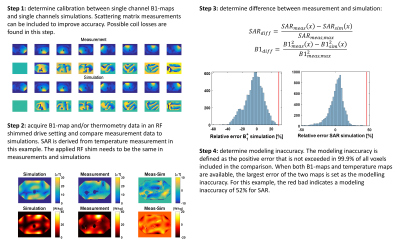 |
Tier based formalism for RF safety assessment of custom-built RF coils providing flexibility in the tradeoff between effort and overestimation
Bart Steensma1, Peter Luijten1, Dennis Klomp1, Nico van den Berg2, and Alexander Raaijmakers1,3
1Center for Image Sciences, Radiology, University Medical Center Utrecht, Utrecht, Netherlands, 2Center for Image Sciences, Radiotherapy, University Medical Center Utrecht, Utrecht, Netherlands, 3Biomedical Engineering, Medical Image Analysis, Eindhoven University of Technology, Eindhoven, Netherlands
We propose an RF safety assessment formalism that uses four tier levels to quantify the accuracy of SAR modeling. Each subsequent tier level consists of more modeling and validation efforts while reducing the overestimation of peak SAR levels. The lowest tier level requires no simulations or measurements whereas the highest tier level includes B1+ and thermometry-based validations. The formalism defines a safety factor to account for deviations between the simulation model and the subject adding errors with the sum-of-squares method. A tier 3 validation and error propagation procedure was conducted for a 7T prostate array.
|
|
4194.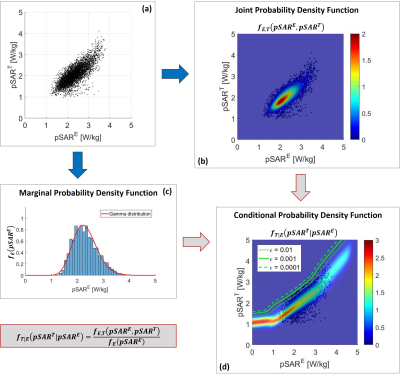 |
A conditional safety margin to reduce the peak local SAR overestimation due to the conventional safety factor
E. F. Meliado1,2,3, A. Sbrizzi1,2, C.A.T. van den Berg2,4, B. R. Steensma1,2, P.R. Luijten1, and A. J. E. Raaijmakers1,2,5
1Department of Radiology, University Medical Center Utrecht, Utrecht, Netherlands, 2Computational Imaging Group for MR diagnostics & therapy, Center for Image Sciences, University Medical Center Utrecht, Utrecht, Netherlands, 3Tesla Dynamic Coils BV, Zaltbommel, Netherlands, 4Department of Radiotherapy, Division of Imaging & Oncology, University Medical Center Utrecht, Utrecht, Netherlands, 5Biomedical Image Analysis, Dept. Biomedical Engineering, Eindhoven University of Technology, Eindhoven, Netherlands
The introduction of a linear safety factor to address peak local SAR uncertainties (e.g. inter-subject variation and modeling inaccuracies) bears one considerable drawback: it often results in over-conservative scanning constraints. In this work, we present a more efficient and probabilistic approach to define a variable safety margin based on the conditional probability density function of the true peak local SAR value given the estimated peak local SAR value. Results show that the proposed approach leads to a reduction of peak local SAR overestimation up to 30%.
|
|
4195.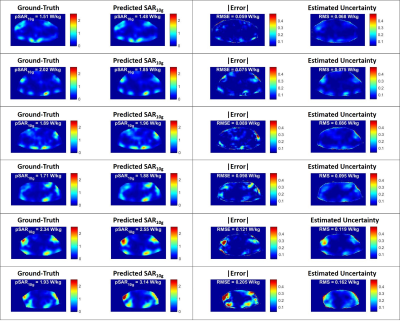 |
Subject-specific local SAR assessment with corresponding estimated uncertainty based on Bayesian deep learning
E.F. Meliado1,2,3, A. J. E. Raaijmakers1,2,4, M. Maspero2,5, M.H.F. Savenije2,5, A. Sbrizzi1,2, P.R. Luijten1, and C.A.T. van den Berg2,5
1Department of Radiology, University Medical Center Utrecht, Utrecht, Netherlands, 2Computational Imaging Group for MR diagnostics & therapy, Center for Image Sciences, University Medical Center Utrecht, Utrecht, Netherlands, 3Tesla Dynamic Coils BV, Zaltbommel, Netherlands, 4Biomedical Image Analysis, Dept. Biomedical Engineering, Eindhoven University of Technology, Eindhoven, Netherlands, 5Department of Radiotherapy, Division of Imaging & Oncology, University Medical Center Utrecht, Utrecht, Netherlands
For local SAR assessment, it is not possible to completely model the actual examination scenario, and residual experimental uncertainties are always present. Currently, no methods provide an estimate of the spatial distribution of confidence in the assessed local SAR. We present a Bayesian deep learning approach to map the relation between subject-specific complex B1+-maps and the corresponding local SAR distribution, and to predict the spatial distribution of uncertainty at the same time. First results show the feasibility of the proposed approach providing potential for subject-specific reduction of uncertainties in peak local SAR assessment.
|
|
4196.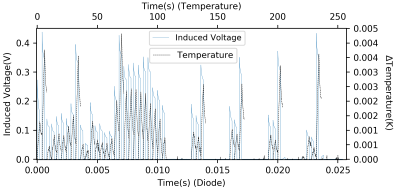 |
Real-time safety assessment and mitigation of RF induced implant heating with parallel transmission and low-cost RMS sensors.
Berk Silemek1, Lukas Winter1, Frank Seifert1, Harald Pfeiffer1, Reiner Seemann1, Werner Hoffmann1, and Bernd Ittermann1
1Physikalisch-Technische Bundesanstalt, Berlin, Germany
In this work, we implement a fast and accurate safety monitoring and prediction for pTx based mitigation of implant heating using fast, cheap and easy to implement rms sensors. The proof of concept is demonstrated with a guidewire substitute in an 8-channel pTx RF coil setup at 300MHz. The signals from the field sensor and temperature sensor at the guidewire tip correlated well. The pTx mitigation obtained within 25.6ms showed significant heating reduction verified by temperature measurements. The method does not require additional simulations or in vitro testing and is potentially applicable in a patient and exam specific clinical setting.
|
|
4197.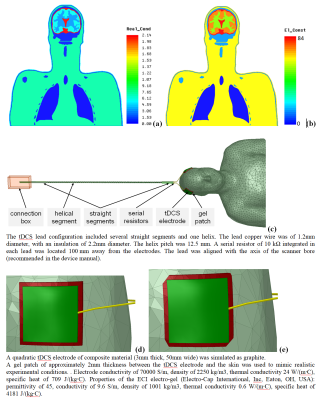 |
Multi-Physics Co-Simulation of Heating Due to Transcranial Direct Current Stimulation at 3T
Mikhail Kozlov1, Nikolaus Weiskopf2, and Harald Möller3
1Neurophysics, Max-Planck-Institute for Human Cognitive and Brain Sciences, Leipzig, Germany, 2Neurophysics, Max Planck Institute for Human Cognitive and Brain Sciences, Leipzig, Germany, 3Nuclear Magnetic Resonance Unit, Max Planck Institute for Human Cognitive and Brain Sciences, Leipzig, Germany
We modelled RF-induced power deposition and temperature rise at 3T due to presence of standard tDCS equipment using an high resolution human head and torso model. The influence of gel pad geometry on the power deposition was analysed. Our case study provided strong evidence that (i) the tDCS setup has a relevant impact on temperature rise at skin in proximity of tDCS electrode edges at 3T, (ii) assessing temperature rise due to presence of the tDCS setup using one or a few temperature probes located in gel at arbitrary positions cannot be considered as a reliable procedure.
|
|
4198.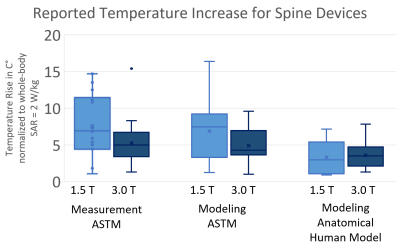 |
Retrospective Analysis of Radio-frequency Safety of Orthopedic Passive Implantable Device
Kyoko Fujimoto1, An Smith1,2, Leonardo M Angelone1, Vikansha Dwivedi1, Sunder S Rajan1, Brent L Showalter1, and Nicole LL McMinn1
1Center for Devices and Radiological Health, US Food and Drug Administration, Silver Spring, MD, United States, 2University of Virginia, Charlottesville, VA, United States
Implantable medical devices marketed in the US may include MRI Safety Information, to allow patients with such devices to safely undergo MR scans. However, some implantable devices are not evaluated for MR compatibility due to constraints of the testing cost and other resources. Not having MRI Safety Information in labeling limits patients’ access to MR scans. This study aimed to perform a retrospective analysis of MR safety testing data included in previously cleared 510(k) submissions for implantable orthopedic devices, with the goal to generate datasets that may help establish guidelines that potentially reduce the regulatory burden for future pre-market submissions.
|
|
4199.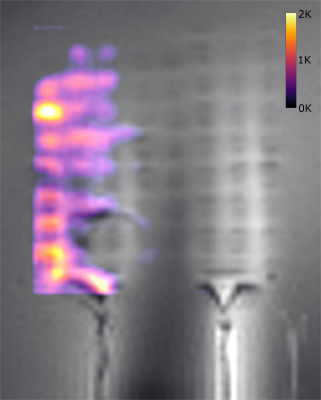 |
RF Heating of a 64-Channel Implantable Electrode Grid: Simulation and Temperature Measurements
Thomas Lottner1, Simon Reiss1, Lukas Vincent Haas1, Johannes Erhardt2, Ali Caglar Özen1,3, Lars Bielak1, Martin Schüttler4, and Michael Bock1
1Dept. of Radiology, Medical Physics, Medical Center – University of Freiburg, Faculty of Medicine, University of Freiburg, Freiburg, Germany, 2Department of Microsystems Engineering—IMTEK, University of Freiburg, Freiburg, Germany, 3German Consortium for Translational Cancer Research Partner Site Freiburg, German Cancer Research Center (DKFZ), Heidelberg, Germany, 4CorTec GmbH, Freiburg, Germany
Active implantable medical devices (AIMD) can restore body function in patients with neurological or other disorders which increases their quality of life considerably. In this work we measure RF-induced heating by MRI thermometry in combination with FOTP measurements and simulations and apply it to a 64-channel electrode grid. The combination of MR thermometry with high spatial resolution, FOTPs with high thermal resolution and supplementary simulations of electromagnetic and thermal processes shows how limitations of the individual methods are overcome and result in a more comprehensive understanding of the thermal dynamics resulting from the exposure of implants to RF-fields.
|
|
4200.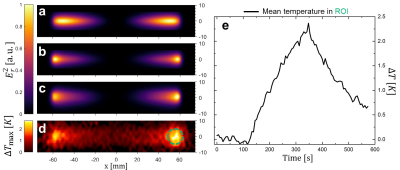 |
Modeling the RF-induced Heating of Stents with an Analytical Model, Electro-Optic E-field Measurements and MR Thermometry
Simon Reiss1, Lukas Haas1, Thomas Lottner1, Ali Özen1, Stefan Polei2, Andreas Bitzer3, and Michael Bock1
1Dept. of Radiology, Medical Physics, Medical Center University of Freiburg, Freiburg, Germany, 2Cortronik GmbH, Rostock-Warnemuende, Germany, 3Institute of Photonics and ICT (IPI), University of Applied Sciences FHGR, Chur, Switzerland
RF-induced currents in stents may cause substantial heating in the surrounding tissue. A precise theoretical calculation of the scattered E-fields is desirable, as heating hot spots occur near the stent surface, which often cannot be measured directly. In this study we present a theoretical model of the scattered E-field of stents and compare it to both electro-optic E-field measurements and MR thermometry. The results demonstrate that the scattered E-field patterns of stents can be precisely calculated from the theoretical model.
|
|
| 4201. | Direct Comparison of In situ Cadaveric Pacemaker Lead-tip Heating to In vitro Configurations
Jessica A. Martinez 1,2, Volkan Acikel3, and Daniel B. Ennis4,5,6
1Radiological Sciences, Stanford University, Stanford, CA, United States, 2Radiological Sciences, UCLA, Los Angeles, CA, United States, 3UCLA, Los Angeles, CA, United States, 4Stanford University, Stanford, CA, United States, 5Division of Radiology, Veteran Affairs Health Care System, Palo Alto, CA, United States, 6Stanford University, Cardiovascular Institute, Palo Alto, CA, United States
In situ RF-induced lead-tip heating was compared for cadavers with previously implanted cardiac-AIMDs to the same AIMDs positioned in the ASTM phantom following an identical lead path at 1.5T
|
|
4202.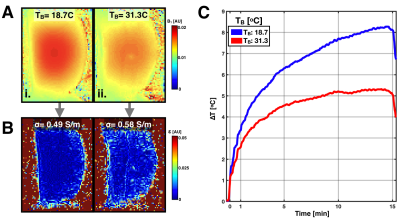 |
RF-Induced Heating During MRI Examinations Depends on The Baseline Temperature
Jessica A. Martinez1, Kevin Moulin1, and Daniel B. Ennis1,2,3
1Radiological Sciences, Stanford University, stanford, CA, United States, 2Division of Radiology, Veteran Affairs Health Care System, Palo Alto, CA, United States, 3Cardiovascular Institute, Stanford University, Stanford, CA, United States RF-induced heating was performed at different baseline temperatures (TB). Along with temperature increase, B1-maps, conductivity (σ) and the dielectric permittivity(ε) were analyzed. when TB increases, σ and ε increase. However, RF- induced heating decreases. |
4203.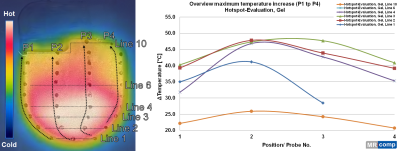 |
Comparing the use of IR cameras with small media layer heights with temperature probe mapping for gradient induced hotspot evaluations
Vincent Hammersen1, Michael Wolff1, Jakob Kreutner1, and Gregor Schaefers2
1R&D, MRI-STaR - Magnetic Resonance Institute for Safety, Technology and Research GmbH, Gelsenkirchen, Germany, 2MR:comp GmbH, Gelsenkirchen, Germany
Gradient induced heating of an AIMD is a serious safety hazard. To examine this risk a time consuming temperature mapping of the device with temperature probes is necessary to characterize hotspots on the implant. The use of IR cameras would directly point out where those hotspots occur and simplify those measurements to fewer mapping runs with temperature probes. But the small solution medium layer heights necessary for imaging could alter the hotspot characteristics. We investigated this problem with a laboratory test system and showed that hotspots neither move nor are affected in its location by different media types.
|
|
4204.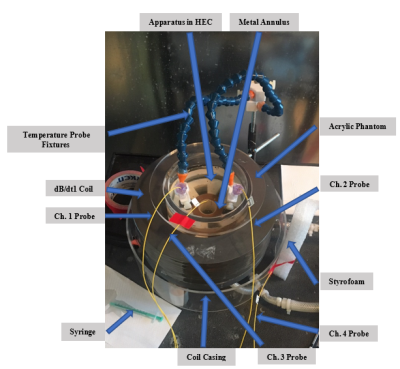 |
Gradient dB/dt Heating Measurements of a Copper Annulus Reference Standard Using a Laboratory dB/dt Exposure System
Joel Crane1, Christine Wawrzyn1, William B. Handler1, and Blaine A. Chronik1
1Physics and Astronomy, Western University, London, ON, Canada
Standardized testing in the field of MR Safety is critical to the functioning of the science and the well-being of the patient. The gradient-induced temperature rise of a copper annulus reference standard was measured using a laboratory dB/dt exposure system to assess measurement repeatability and validation of test system operation. The reference standard was subjected to heating variables, including gradient exposure in various gelled-HEC temperatures and gradient exposure to various frequencies of magnetic field. Results indicate the effect of eddy currents on conductive materials under various testing conditions, which is of significance for passive and active implantable medical devices.
|
|
4205.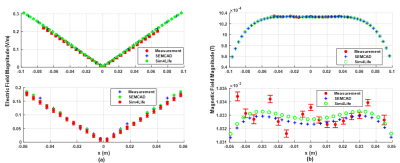 |
Validating low frequency QS solvers in SEMCAD and Sim4life for simulating the effects of gradient fields on devices
Arjama Halder1,2, Ali Attaran2, William B Handler2, and Blaine A Chronik2
1Medical Biophysics, Western University, London, ON, Canada, 2Physics and Astronomy, Western University, London, ON, Canada
A validation study to ensure the EM behavior predicted by the quasi-static solvers in SEMCAD and Sim4Life is accurate.
|
|
4206.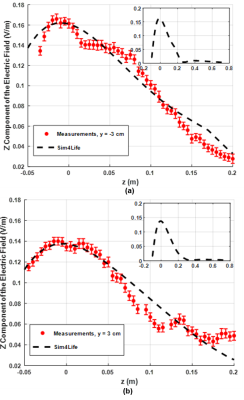 |
Study of gradient induced electric fields in a tissue-mimicking ASTM phantom within an X-Axis gradient coil
Arjama Halder1,2, Ali Attaran2, William B Handler2, and Blaine A Chronik2
1Medical Biophysics, Western University, London, ON, Canada, 2Physics and Astronomy, Western University, London, ON, Canada
Validating measured gradient induced electric fields in a conductive ASTM phantom within an X-Axis gradient coil.
|
|
4207.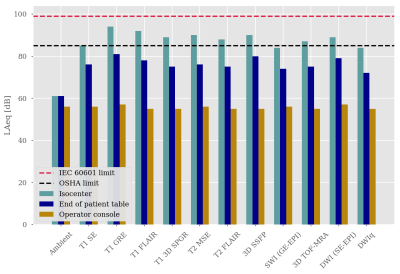 |
Acoustic Behavior of High Performance Imaging on a Head-only 0.5T Scanner with Asymmetric Gradients
Chad T Harris1, Andrew T Curtis1, Curtis N Wiens1, Philip J Beatty1, and Jeff A Stainsby1
1Synaptive Medical, Toronto, ON, Canada
In this work the acoustic behavior of a 0.5T head-only scanner is demonstrated. Measurements of the A-weighted equivalent continuous sound level (LAeq) over a 10-second period were made for typical clinical protocols at three locations: magnet isocenter; within the magnet room but outside the magnet bore; and at the operator console – outside of the magnet room. The LAeq values varied between 84-94 dB, 74-81 dB, and 55-57 dB at the three measurement positions respectively. Notably, outside of the MR room, the LAeq levels were indistinguishable from ambient levels, suggesting minimal environmental acoustic impact near the magnet installation site.
|
|
4208.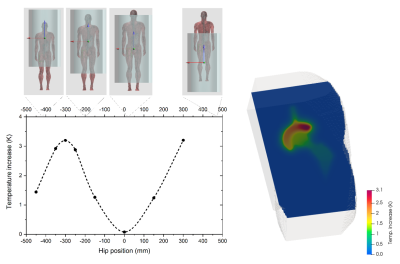 |
Thermal effects produced by gradient switching of Echo-Planar Imaging sequences in metallic hip implants
Alessandro Arduino1, Oriano Bottauscio1, Mario Chiampi1, and Luca Zilberti1
1INRiM, Torino, Italy The temperature increase induced by MRI gradient fields switched according to EPI sequences in a metallic hip implant is evaluated with an accurate numerical model. The role of the body position within the scanner, of the frequency encoding direction and of the thermoregulation is studied and discussed. The results show that the eddy currents generated by the gradient coils in the implant are sufficient to induce a temperature increase of some kelvin (without accounting for the RF power deposition); moreover, it results that the biological effect can be controlled by choosing properly the frequency encoding direction. |
|
| 4209. | Development of an MRI-safe miniature vibrometer for measuring unintended acoustic stimulation during MRI
Guy Fierens1,2,3, Joris Walraevens2, Ronald Peeters4, Nicolas Verhaert3,5, and Christ Glorieux1
1Physics and Astronomy, KU Leuven, Leuven, Belgium, 2Cochlear Technology Centre Belgium, Mechelen, Belgium, 3Neurosciences, KU Leuven, Leuven, Belgium, 4Radiology, UZ Leuven, Leuven, Belgium, 5Otorhinolaryngology, KU Leuven, Leuven, Belgium
Magnetic resonance imaging (MRI) for patients with active implantable medical devices can cause patient harm due to mutual interactions between the device and the electromagnetic fields used by the scanner. Medical device manufacturers subject their devices to a number of tests described in industry standards to assess the general safety of their device. Device specific hazards are not addressed by these standards but can nonetheless lead to patient harm. The presented work describes the design of a miniature vibrometer that can be used to quantify the risk of unintended stimulation of patients with acoustically stimulating auditory implants.
|
|
4210.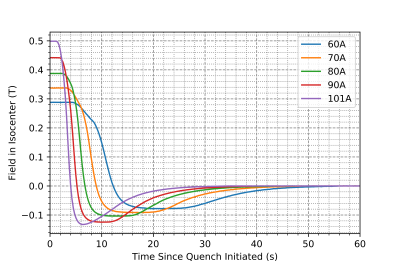 |
Quench Dynamics Across Multiple Field Strengths
Diego F. Martinez1, William B. Handler1, and Blaine A. Chronik1
1The xMR Labs, Physics and Astronomy, Western University, London, ON, Canada
Modern MR developments have allowed for systems which can easily vary the main magnetic field to leverage tissue properties at different field strengths. With this comes a change in the way that these systems handle safe elimination (quench) of main magnetic field in emergency situations. These quench dynamics at variable fields were investigated using a magnetic field probe at the isocenter in the bore of the magnet. The measured propagation dynamics show the need to ensure that the quench circuit used maintains an acceptable quench time, as quench times at the maximum field may not translate to lower field.
|
|
4211.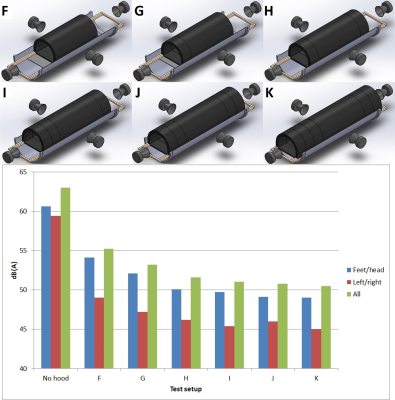 |
Damping of acoustic noise for fetal/neonatal MRI and MR-guided radiotherapy
Erik Rutger Huijing1, Koenraad Rhebergen2, Patrick Stroosnijder3, Dennis Klomp1, Jannie Wijnen1, Mariëlle Philippens4, Kim Annink5, and Stefano Mandija4,6
1Department of Radiology, University Medical Center Utrecht, Utrecht, Netherlands, 2Department of Otorhinolaryngology and Head & Neck Surgery, University Medical Center Utrecht, Utrecht, Netherlands, 3Medical Technology & Clinical Physics, University Medical Center Utrecht, Utrecht, Netherlands, 4Department of Radiotherapy, University Medical Center Utrecht, Utrecht, Netherlands, 5Department of Neonatology, University Medical Center Utrecht, Utrecht, Netherlands, 6Computational Imaging Group for MR Diagnostic & Therapy, University Medical Center Utrecht, Utrecht, Netherlands
In this work, we investigated the noise attenuation provided by different acoustic hood designs particularly relevant for fetal/neonatal MRI and MRI-guided radiotherapy. We experimentally demonstrated that both increasing hood length and thickness have a positive influence on acoustic noise reduction up to 20dB for the investigated scenarios. These results will provide experimental information useful to design a new acoustic hood for different applications, e.g. neonatal MRI and MR-guided radiotherapy.
|
|
4212.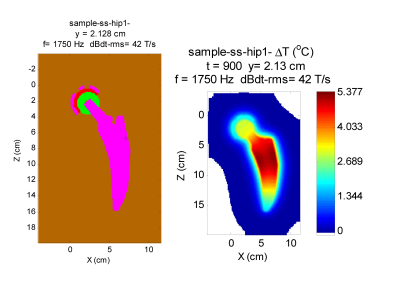 |
Heating and torque of passive metallic implants by gradient dBdt and static field B0 in MRI
John A Nyenhuis1
1Electrical Engineering, Purdue University, West Lafayette, IN, United States
The objective was to calculate heating and torque, which results in vibration, by the time-varying magnetic field dBdt from the gradients in MRI to identify which passive implants will have the largest gradient interactions. A large hip stem and an acetabular hip shell were selected as worse case practical implants for gradient interactions. Maximum temperature rise under the intense dBdt inputs (42 T/s, 1750 Hz, 15 minutes exposure) of ISO/IEC 10974 is 5.4 $$$^{\circ}$$$C for the hip stem and 7.0 $$$^{\circ}$$$C for the acetabular shell. Gradient torque was about 4 times the gravity value for the acetabular shell.
|
|
4213.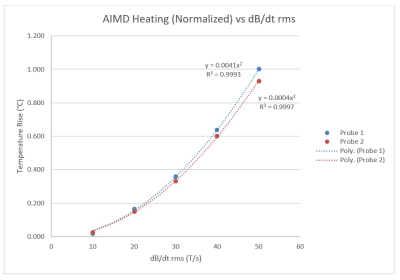 |
MRI Gradient Induced Device Heating of Active Implantable Medical Devices vs Gradient Magnetic Field (dB/dt rms)
Michael Childers1 and Shiloh Sison2
1Abbott, Sylmar, CA, United States, 2Abbott, Sunnyvale, CA, United States
As part of the MR safety assessment for AIMDs per ISO/TS 10974, an evaluation for gradient induced device heating must be performed. For this evaluation, the temperature response of the device is assumed to be proportional to the square of dB/dt rms. While this has been shown to be true for simple structures like a conductive disk, no testing has been presented showing that this relationship is still valid for more complex AIMDs structures. In this abstract we therefore provide testing, on a representative AIMD, confirming gradient induced device heating for AIMDs is proportional to the square of dB/dt rms.
|
|
4214.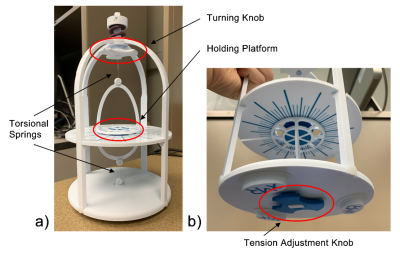 |
Proposed Calibration of the Torsional Spring in Torque Measurement Method Described in ASTM F2213-17
Xiao Fan Ding1, William Handler1, Dereck Gignac1, and Blaine Chronik1
1The xMR Labs, Department Physics and Astronomy, Western University, London, ON, Canada
The procedure for the 'Torsional Spring Method' from the internationally recognized standard on measuring induced torque on medical implants, ASTM F2213-17, leaves out information regarding the calibrating and quantifying of the spring constant which is crucial for its use in calculating torque. This abstract is a proposed method for the purpose of calibrating a torsion balance to enhance the utility of this internationally recognized test standard.
|
|
4215.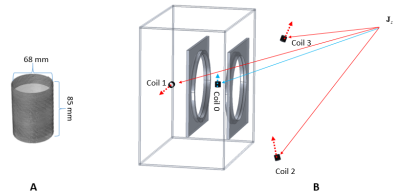 |
Convolutional neural network based software gradiometer for noise attenuation in ultra-low field MRI
Jiasheng Su1, Ruben Pellicer Guridi1, Viktor Vegh1, and David Reutens1
1Centre for Advanced Imaging, The University of Queensland, Brisbane, Australia
Ultra-low field MR systems rely on bulky and expensive shielding enclosures that attenuate the large ambient electromagnetic ambient noise intrinsic to this regime. This increases system costs and hinders portability. To reduce this shielding constraint we propose using a software gradiometer based on convolutional neural networks. The presented approach employs three peripheral coils to estimate the ambient noise interfering with the NMR acquisition. Preliminary results suggest that this method can provide a significant noise reduction. Such a system could considerably reduce shielding requirements promoting the system’s portability and reducing its costs.
|
|
4216.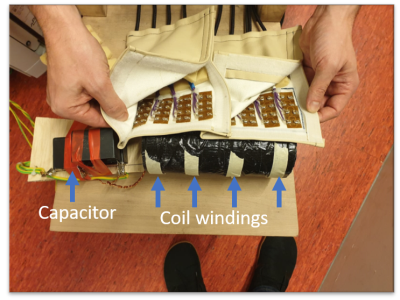 |
Overcome PNS for ultrasonic body gradients: concept
Edwin Versteeg1, Jeroen Siero1,2, and Dennis Klomp1
1Radiology, University Medical Center Utrecht, Utrecht, Netherlands, 2Spinoza Centre for Neuroimaging Amsterdam, Amsterdam, Netherlands
Ultrasonic MRI has been demonstrated successful for dedicated short head gradients running with slew rates over 5000T/m/s without experiencing painful peripheral nerve stimulation. However, this requires insert coils with complex cooling and high power connecters that limit its ease of use. More elegant would be to translate the technology to body gradients, yet operation of use will come to audible frequencies when avoiding PNS. Here we show a 20kHz setup that uses a 5 lobe polynomial rather than linear gradient in Z-direction combined with high channel SENSE unfolding that can reduce PNS 5-fold so to maintain ultrasonic.
|
|
4217.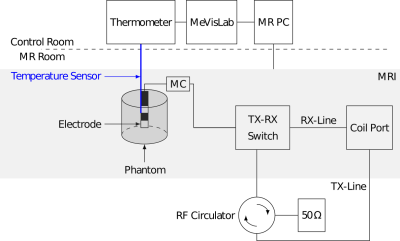 |
Power Control for an MRI Ablation Hybrid System
Thomas Gerlach1, Enrico Pannicke1, Julian Alpers1, Christian Hansen1, Oliver Speck1, and Ralf Vick1
1Otto-von-Guericke University Magdeburg, Magdeburg, Germany
Connecting an ablation electrode directly to the coil port of the MR
|
|
4218.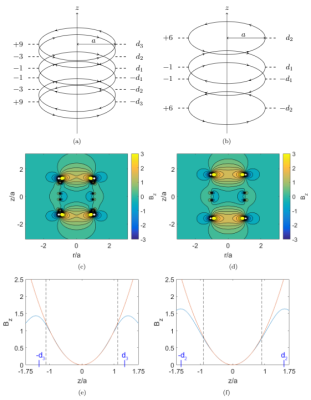 |
Design of shim coils by combination of simple building blocks: Romeo and Hoult revisited
Michael Packer1, Mark Fromhold1, and Richard Bowtell2
1School of Physics and Astronomy, University of Nottingham, Nottingham, United Kingdom, 2Sir Peter Mansfield Imaging Centre, University of Nottingham, Nottingham, United Kingdom
Shim coils can be formed from combinations of small numbers of simple “building block” coils (loops and saddles). In a seminal 1984 paper, Romeo and Hoult, showed how to combine building blocks to produce coils that generate a given spherical harmonic, whilst eliminating contamination from as many unwanted spherical harmonic terms as possible. By applying updated numerical optimisation approaches to this problem, we show how to produce improved zonal shim coils. Designs of Z2, Z3 and Z4 coils formed from three pairs of loops, which are shorter than previously reported coils while having large regions of conformity are described.
|

 Back to Program-at-a-Glance
Back to Program-at-a-Glance View the Poster
View the Poster Watch the Video
Watch the Video Back to Top
Back to Top